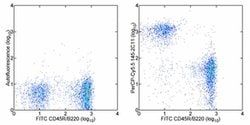Ki-67 Monoclonal Antibody (20Raj1), eFluor™ 615, eBioscience™, Invitrogen™
Mouse Monoclonal Antibody
Manufacturer: Fischer Scientific
The price for this product is unavailable. Please request a quote
Antigen
Ki-67
Concentration
0.2 mg/mL
Classification
Monoclonal
Form
Liquid
Regulatory Status
RUO
Formulation
PBS with 0.09% sodium azide; pH 7.2
Gene Alias
antigen identified by monoclonal antibody Ki 67; antigen identified by monoclonal antibody Ki-67; Antigen identified by monoclonal antibody Ki-67 homolog; Antigen KI-67; Antigen KI-67 homolog; antigen KI-67; proliferation marker protein Ki-67; antigen KI-67-like; cb31; D630048A14Rik; I79_022666; Ki67; Ki-67; KIA; LOW QUALITY PROTEIN: proliferation marker protein Ki-67; marker of proliferation Ki-67; MIB-; MIB-1; Mki67; PPP1R105; Proliferation marker protein Ki-67; proliferation-related Ki-67 antigen; protein phosphatase 1, regulatory subunit 105; RP11-380J17.2; sb:cb31; si:ch211-250b22.7; unnamed protein product; wu:fa11g09; wu:fb57a07; wu:fi14e05
Gene Symbols
Mki67
Primary or Secondary
Primary
Content And Storage
4° C, store in dark, DO NOT FREEZE!
Gene
Mki67
Clone
20Raj1
Applications
Immunocytochemistry, Immunohistochemistry (Paraffin)
Conjugate
eFluor 615
Host Species
Mouse
Target Species
Canine, Human
Gene Accession No.
P46013
Gene ID (Entrez)
100686578, 4288
Isotype
IgG1 κ
Purification Method
Affinity chromatography
Product Type
Antibody
Description
- Description: The monoclonal antibody 20Raj1 recognizes the human Ki-67 protein
- Two isoforms of Ki-67 exist, a 345 and 395 kDa form that are expressed in dividing cells
- Ki-67 is expressed in all cell types and is detectable during active phases of the cell cycle (G1, S, G2, and mitosis) but is absent from resting cells (G0)
- During interphase, Ki-67 expression is localized to the nucleus but redistributes to the chromosomes during mitosis and has specifically been found to associate with heterochromatin-bound proteins such as chromobox protein homolog 3 (CBX3)
- In studies of tumor cells, Ki-67 expression has been used as a marker for determining the fraction of proliferating cells within a given population of tumor cells
- This monoclonal antibody 20Raj1 recognizes canine Ki-67
- Applications Reported: This 20Raj1 antibody has been reported for use in immunocytochemical and immunohistochemical staining of paraffin-embedded tissue (IHC-P)
- Applications Tested: This 20Raj1 antibody has been tested by immunocytochemistry on formaldehyde-fixed and permeabilized HeLa cells, and immunohistochemistry on FFPE human skin using low pH antigen retrieval
- For immunocytochemistry and immunohistochemistry, this can be used at less than or equal to 1 μg/mL
- It is recommended that the antibody be carefully titrated for optimal performance in the assay of interest
- Ki-67 is a nuclear protein that is expressed during various stages in the cell cycle, particularly during late G1, S, G2, and M phases
- The protein has a forkhead associated domain (FHA) through which it associates with euchromatin at the perichromosomal layer, the centromeric heterochromatin, and the nucleolus
- Ki-67 is shown to have a cell cycle dependent topographical distribution with perinucleolar expression at G1, expression in the nuclear matrix at G2, and expression on the chromosomes during M phase
- Ki-67 is commonly used as a proliferation marker because it is not detected in G0 cells, but increases steadily from G1 through mitosis
- Ki-67 antibodies are useful in establishing the cell growing fraction in neoplasms
- In neoplastic tissues, the prognostic value is comparable to the tritiated thymidine-labelling index
- The correlation between low Ki-67 index and histologically low-grade tumors is strong
- Ki-67 is routinely used as a neuronal marker of cell cycling and proliferation.



